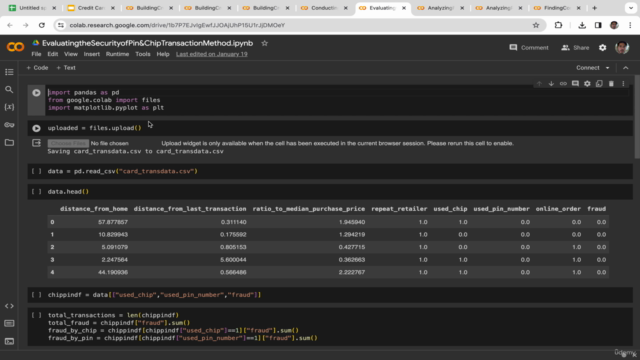Building Credit Card Fraud Detection with Machine Learning

Why take this course?
🎓 Course Title: Building Credit Card Fraud Detection with Machine Learning
Headline: Master Credit Card Fraud Detection with Random Forest, Logistic Regression & Support Vector Machine 🚀
Introduction:
Welcome to the Building Credit Card Fraud Detection Model with Machine Learning course! This project-based journey is meticulously designed for data scientists and enthusiasts eager to delve into the fascinating world of fraud detection. With a focus on machine learning, you'll explore the nuances of credit card fraud using logistic regression, support vector machine, and random forest algorithms. 📊🌿
Course Overview:
This course is a trifecta of knowledge:
- Data Analysis: Dive deep into the credit card dataset, uncover patterns, and understand data intricacies.
- Predictive Modeling: Harness big data to build an accurate fraud detection model.
- Model Evaluation: Master the art of assessing your model's precision, recall, and F1 score to ensure top-notch performance.
Why this Course?
In a digital era where online transactions are the norm, understanding credit card fraud detection is crucial. This course equips you with the skills to protect financial integrity, safeguard users from fraudulent activities, and stay ahead of sophisticated fraudsters. By leveraging cutting-edge machine learning algorithms, you'll play a pivotal role in maintaining the security of online payment systems. 🛡️
What You Will Learn:
- Fundamentals of Fraud Detection Models: Get acquainted with the core concepts and practical applications in fraud detection.
- Credit Card Fraud Model Workings: From data collection to real-time processing, understand each step in creating an effective model.
- Common Credit Card Fraud Cases: Identify various types of fraud such as card skimming, phishing attacks, identity theft, and more.
- Kaggle Dataset Acquisition: Learn how to source and download datasets for your analyses.
- Dataset Cleaning: Remove missing rows and duplicates to ensure the integrity of your data.
- Chip & PIN Security Evaluation: Analyze the security of transaction methods like chip and pin.
- Retailer Fraud Pattern Analysis: Recognize repeat retailer fraud patterns and their implications.
- Transaction Amount vs. Fraud Correlation: Find correlations that can inform your model's decision-making process.
- Fraud Case Analysis in Online Transactions: Learn to analyze and detect fraud within online transactions.
- Feature Selection with Random Forest: Utilize Random Forest for effective feature selection.
- Modeling with Random Forest, Logistic Regression & Support Vector Machine: Build and apply these models to your credit card fraud detection project.
- Performance Evaluation: Use precision, recall, and F1 score to evaluate the accuracy of your model.
Course Structure:
- Introduction to Fraud Detection Models: Understand the basics and the importance of these models in today's digital landscape.
- In-Depth Project Guide: Set up your Google Colab IDE, download your dataset from Kaggle, and prepare for the hands-on learning experience.
- Data Analysis and Visualization: Explore the dataset to uncover insights and inform your model building process.
- Building the Fraud Detection Model: Step by step instructions on creating a fraud detection model using logistic regression, support vector machine, and random forest.
- Model Evaluation and Testing: Learn how to test and refine your model to ensure it is both accurate and effective in real-world scenarios.
- Final Project: Apply your knowledge to build and evaluate a fraud detection model capable of handling various types of credit card fraud.
- Real-World Application: Understand how to apply these skills in future opportunities within the field of cybersecurity and data science.
Join us on this exciting learning adventure and become a guardian against the ever-evolving threat of credit card fraud! 🛡️💳✨
Course Gallery




Loading charts...